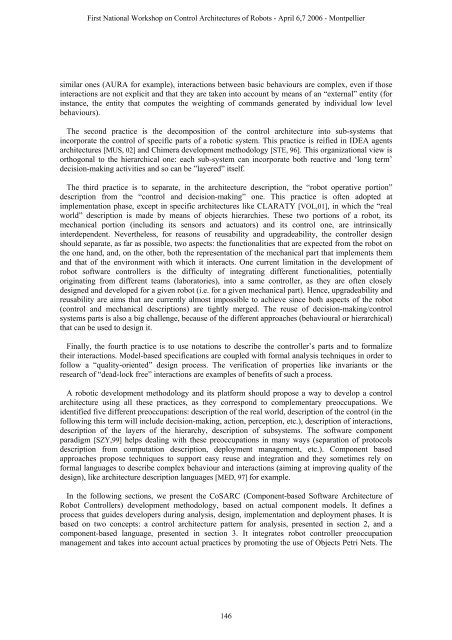Pleading for open modular architectures - Lirmm
Pleading for open modular architectures - Lirmm
Pleading for open modular architectures - Lirmm
Create successful ePaper yourself
Turn your PDF publications into a flip-book with our unique Google optimized e-Paper software.
First National Workshop on Control Architectures of Robots - April 6,7 2006 - Montpellier<br />
similar ones (AURA <strong>for</strong> example), interactions between basic behaviours are complex, even if those<br />
interactions are not explicit and that they are taken into account by means of an “external” entity (<strong>for</strong><br />
instance, the entity that computes the weighting of commands generated by individual low level<br />
behaviours).<br />
The second practice is the decomposition of the control architecture into sub-systems that<br />
incorporate the control of specific parts of a robotic system. This practice is reified in IDEA agents<br />
<strong>architectures</strong> [MUS, 02] and Chimera development methodology [STE, 96]. This organizational view is<br />
orthogonal to the hierarchical one: each sub-system can incorporate both reactive and ‘long term’<br />
decision-making activities and so can be ”layered” itself.<br />
The third practice is to separate, in the architecture description, the “robot operative portion”<br />
description from the “control and decision-making” one. This practice is often adopted at<br />
implementation phase, except in specific <strong>architectures</strong> like CLARATY [VOL,01], in which the “real<br />
world” description is made by means of objects hierarchies. These two portions of a robot, its<br />
mechanical portion (including its sensors and actuators) and its control one, are intrinsically<br />
interdependent. Nevertheless, <strong>for</strong> reasons of reusability and upgradeability, the controller design<br />
should separate, as far as possible, two aspects: the functionalities that are expected from the robot on<br />
the one hand, and, on the other, both the representation of the mechanical part that implements them<br />
and that of the environment with which it interacts. One current limitation in the development of<br />
robot software controllers is the difficulty of integrating different functionalities, potentially<br />
originating from different teams (laboratories), into a same controller, as they are often closely<br />
designed and developed <strong>for</strong> a given robot (i.e. <strong>for</strong> a given mechanical part). Hence, upgradeability and<br />
reusability are aims that are currently almost impossible to achieve since both aspects of the robot<br />
(control and mechanical descriptions) are tightly merged. The reuse of decision-making/control<br />
systems parts is also a big challenge, because of the different approaches (behavioural or hierarchical)<br />
that can be used to design it.<br />
Finally, the fourth practice is to use notations to describe the controller’s parts and to <strong>for</strong>malize<br />
their interactions. Model-based specifications are coupled with <strong>for</strong>mal analysis techniques in order to<br />
follow a “quality-oriented” design process. The verification of properties like invariants or the<br />
research of “dead-lock free” interactions are examples of benefits of such a process.<br />
A robotic development methodology and its plat<strong>for</strong>m should propose a way to develop a control<br />
architecture using all these practices, as they correspond to complementary preoccupations. We<br />
identified five different preoccupations: description of the real world, description of the control (in the<br />
following this term will include decision-making, action, perception, etc.), description of interactions,<br />
description of the layers of the hierarchy, description of subsystems. The software component<br />
paradigm [SZY,99] helps dealing with these preoccupations in many ways (separation of protocols<br />
description from computation description, deployment management, etc.). Component based<br />
approaches propose techniques to support easy reuse and integration and they sometimes rely on<br />
<strong>for</strong>mal languages to describe complex behaviour and interactions (aiming at improving quality of the<br />
design), like architecture description languages [MED, 97] <strong>for</strong> example.<br />
In the following sections, we present the CoSARC (Component-based Software Architecture of<br />
Robot Controllers) development methodology, based on actual component models. It defines a<br />
process that guides developers during analysis, design, implementation and deployment phases. It is<br />
based on two concepts: a control architecture pattern <strong>for</strong> analysis, presented in section 2, and a<br />
component-based language, presented in section 3. It integrates robot controller preoccupation<br />
management and takes into account actual practices by promoting the use of Objects Petri Nets. The<br />
146

















